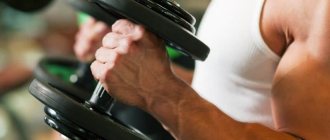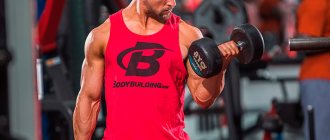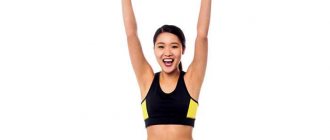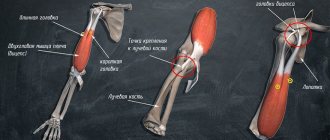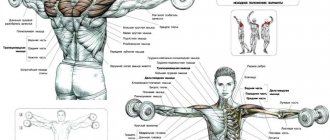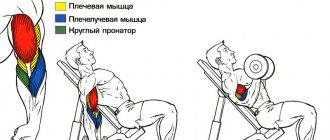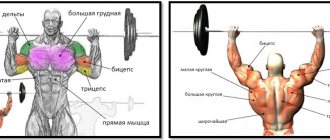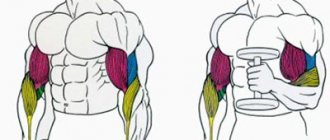Content
- 1 Brief description of the exercise
- 2 How to do this exercise
- 3 Recommendations and number of repetitions
- 4 Lifting dumbbells with emphasis
Standing dumbbell curl
This exercise is basic for the biceps muscle, as well as for the forearm muscle. It involves rotating the hand outward. In this way, it is possible to ensure contraction of the biceps, as well as the muscles that are synergists of the biceps. It is not without reason that this exercise is one of the best for developing biceps.
Brief description of the exercise
This exercise can be performed standing with supination, or sitting. There are variations of the exercise when it is done alternately or in series. In the first case, the exercise is done alternately, first with one hand, and then with the other. In the second case, say, ten repetitions are done with one hand, and then the same number with the other hand. It is also possible that the exercise with dumbbells is done without supination. In this case, these will be regular dumbbell lifts to train the biceps.
During the training process, not only one biceps works intensively. The exercise is also designed to train the forearm and brachialis muscles. Their work can be described as follows:
- The brachialis, or brachialis muscle, flexes the arm at the elbow;
- The biceps muscle, or biceps, also flexes the arm at the same joint and rotates the forearm;
- The brachioradialis muscle helps flex the arm at the elbow;
- The pronator, located near the elbow, is a synergist for flexion of the arm at this joint.
Work of muscles and joints
The main working muscle group when performing dumbbell lifts with supination is the biceps, and for the most part it is the internal bundle. In addition to the biceps, the forearm and brachioradialis muscles also receive stress. If the athlete violates the technique of performing the exercise, he will also load the anterior delta and even the latissimus dorsi muscles. It goes without saying that the delta and lats will easily take the load away from the biceps, which is easy to understand by simply comparing the weights with which you train these muscles. If you have trouble feeling your biceps, then try moving your elbows forward, this will definitely help!
The exercise is isolating, as evidenced by only one working joint, namely the elbows, although, of course, the wrist also receives a load, but flexion occurs only in the elbow joint. In general, there are no real basic exercises for training biceps, there are only conditionally basic ones, so dumbbell lifts with supination, in fact, are no different in terms of “basicity” from other biceps exercises, but they should be performed with less weight and better quality. technology. Why? Because otherwise you won’t be able to supinate your hand!
How to do this exercise
Lifting dumbbells for biceps while standing
The technique for performing this exercise is as follows.
- Starting position – sitting (you can also stand), feet should be placed shoulder width apart. Hands with dumbbells are lowered, and palms are turned inward.
- We inhale and hold our breath. At the same time, the dumbbells are lifted.
- At the moment when the forearms are parallel to the floor, the hands turn outward. The exercise does not stop, as the dumbbells must be raised as high as possible.
- The dumbbells are lowered, while the hands move in the opposite position.
- When the elbows bend at a right angle, the dumbbells return to their original position and lower down.
Recommendations and number of repetitions
The exercise can be done much more effectively if you keep your elbows in a stationary position. If you press them to the sides and fix them, the biceps will strain more. And if you involuntarily move your elbows forward, then the biceps will be less loaded. Keep an eye on this to achieve the best possible result.
The hand should be turned when the elbow is bent at an angle of 90 degrees. It is dangerous to turn the hand earlier or later, as you can get injured.
It is also important to select such a dumbbell weight so that you can optimally perform the exercise technique without disturbing it.
The number of repetitions in this case should not be more than 12. There is no need to do more than four approaches. It is also not recommended to train such muscle groups more than once or twice a week. This is because they can be easily overtrained, which is not necessary to achieve better results.
Biceps Curl
As functional training has become so popular in the fitness industry and among ordinary people, the biceps curl exercise has become almost illegal. Like all new ideas, this one was also met with hostility. Are bicep curls really that bad? Of course not! A better question to ask is, “How often do we do these types of exercises and what part of the workout do they make up?”
Biceps can be very useful and can teach us important things about movement. In modern fitness, it is common to focus on intense and fast training. It is not surprising that the number of injuries is rapidly increasing without achieving the goals set. Everyone can benefit from preparing the body for more
Make sure you pull your shoulders back correctly. Strength is often lacking in this area. One more thing: Pull-ups are a good exercise, but they can cause internal rotation of the shoulders if done too often. Considering that many people slouch, I would like them to pay attention to this problem.
When performing different variations, do not forget about the tempo. As we said earlier when discussing the bent-over row, many people rush through this movement. Gradually reduce the pace! Perform the exercise with pauses and alternate repetitions. If this is difficult, don't worry. In addition, you can do a number of exercises that you will find at the end of the book.
intense training. Do you still think that biceps curls are unnecessary? Some of the strongest athletes in the world disagree with you!
Competitive athletes have long performed bicep curls to prevent bicep tears. The enormous stress placed on tendons and muscles during classic exercises such as rock carries or farmer's walks makes it necessary to include biceps curls in your training arsenal. Listen to professional athletes and renowned strength coach Jason Nunn:
“Tears in the peripheral biceps muscles are very common among strongmen. Doing a lot of repetitions of biceps curls will help increase the tensile strength of the tendons involved in the exercise.”
I don’t think that a few sets of biceps curls will be grounds for excluding you from the functional training club!
See also: Machine intelligence
You can't limit yourself to biceps exercises to take full advantage of these underrated exercises. Let's abstract from what happens to the hands during their execution. If we look at our body, we see that bicep curls engage the upper body and core muscles to a significant degree, especially when adding weight or adding additional load to the grip. When the weight is in front of the body in the initial phase of biceps curls, you have to actively pull your shoulders down and back, while stiffening your legs and tightening your buttocks.
That's right! Many of the tips I've given in other DTSP exercises to improve stability apply to this exercise as well. People too often allow themselves to slouch and twist under the weight while performing biceps curls. If you follow the DTSP system's recommendations for stability, you will find that your upper back and core muscles are just as tight as your biceps, even though they are not moving. This is just resistance to the weight of the universal sandbag, which pulls the body forward. Another chance to teach people the concept of proper movement doesn't seem like a waste of time to me!
Like bent over rows, using a universal sandbag for biceps curls has many variations. We can not only bend it in different grip and body positions, but also perform the exercise with one hand or two. We can even work with a universal bag full of sand in a range of unique grip positions.
My favorite thing to do is work with the utility bag in an upright position.
Instead of using the handles, I suggest using the bag itself. This involves two important variables. The most obvious thing is that when we let go of the handles, our fingers and grip take on more stress. Like the bent-over row, it improves the efficiency of the upper body muscles and gives a good workout to the arms. Developing grip and biceps strength at the same time is double luck!
See also: LIGHT WEIGHT
What's less obvious is that until you start doing bicep curls while holding a utility sandbag upright, you feel the weight being pulled in the opposite direction. Generally, the weight of a utility sandbag appears to be greater in this position, likely due to the unique combination of leverage and grip strength. Performing biceps curls at the end of a workout or as part of a program is effective and aligns with our functional training ideals.
Having competed in modern strongman competitions, I can tell you that weight bearing puts significant stress on a wide variety of muscle groups. Some trainers, such as Dan John, believe that weight transfer may represent a whole new exercise:
“...weight bearing does more to develop athletic performance than any other exercise I have attempted in my entire career as a coach and athlete. And I'm not saying it's easy."
What makes weight bearing a unique exercise? When you hold a weight, your body instantly begins to feel pressure. To maintain core posture, both major and minor muscles must be activated. The combination of all the body's muscles working together helps activate the natural "weight lifter's belt" to create spinal stability. It seems so.
I think the combination of this body pressure and walking creates a new dimension to this type of training. After all, if you perform a lot of exercises of the DTSP system, this is not the first time that you are under weight pressure. Exercises in this system, such as front squats, shoulder lunges, and even side bag rows and overhead presses, place significant pressure on the body. I find that everything feels different when the exercise is done while walking.
Walking seems so simple. After all, we do this every day! Walking with a weight changes everything because the sensation of weight varies with each step. As with all exercises in the DTSP system, the goal is not only to complete the task, but also to do it correctly.
Similar articles
- Bent-over row
- "Bear Hug"
- Ways to consistently increase the load
Lifting dumbbells with emphasis
Seated dumbbell curls
For this you will need a bench. This version of the exercise will help you reach the peak level of biceps tension. The stages of performing the exercise are as follows.
- You need to sit on a bench and take a dumbbell in one hand. We rest our elbow on the inner thigh. The forearm is straight.
- The hand is raised to the shoulder, while the wrist and back are kept straight.
- We slowly return to the starting position.
This exercise option effectively trains the biceps. By following these recommendations, you can effectively train the volume and strength of the biceps muscle, depending on what goals the athlete sets for himself.
Lifting dumbbells for biceps with supination technique from A to Z
Lifting dumbbells for biceps with supination (rotation) is a basic exercise designed to develop biceps.
Supination raises can be performed both standing and sitting, and if the exercise is performed while sitting on an incline bench, it allows you to effectively work the outer fascicles of the biceps, the development of which is usually delayed.
The biceps performs a dual function: it bends the arm at the elbow joint and turns it outward. It is these functions that are trained during the exercise, resulting in a more complete contraction of the biceps.
"Arachidonic acid"
In addition to it, the biceps curl with supination also involves the pronator teres, brachialis (brachial muscle) and the muscles of the forearm.
The brachialis, located under the biceps, is involved in flexing the arm. If you train it by increasing its volume, it will lift the biceps, thereby increasing the volume and definition of the muscles.
Execution technique
Both simultaneous and alternating dumbbell lifting are practiced. Alternate lifting will take more time and will reduce the intensity of the training, but it will allow you to properly work out the technique, so it should be recommended only at the initial stage. The exercise is performed in 3-4 sets of 8-12 repetitions. To provide the muscles with more intense blood supply, which will increase efficiency, it is recommended to stretch the biceps after each approach. Performing dumbbell lifts with supination while sitting, especially on an incline bench, completely isolates the biceps from the help of other muscle groups (body, legs) and gives maximum load to both of its bundles. In addition, in this position he is already stretched from the very beginning. Lifting dumbbells with supination is done to such a level that the wrists can touch the shoulders. However, you should not press them, so as not to lighten the load on the biceps. Thus, the distance between the shoulders and wrists at the top of the dumbbell lift should be several centimeters. In order to constantly maintain tension in the biceps, the elbow joint should not be fully extended - it should be fixed in the plane of the body, without moving either forward or backward. As for the weight of dumbbells, it should not be too large, especially at the initial stage - this can negatively affect the technique, especially for girls and beginners. It is preferable to start with medium and light weight, and then you can increase it
If the goal of the workout is to burn fat, then it is advisable to use lighter dumbbells, but increase the pace of the exercise and the number of repetitions in it. It is very important to grip the dumbbell correctly to ensure maximum effect from supination. To do this, you need to take it not in the center, but closer to the edge at the thumb, then the heavier part of the dumbbell will be at the little finger, and then when turning, the supinating function will be actively involved. For maximum load after bending and maximum rotation (supination) of the arm, it is necessary to linger for a couple of seconds at peak tension on the muscles, and then smoothly return the arm to its original position
In general, all movements should be smooth, without sudden jerks, to avoid injury.
"Fullbody workout"
